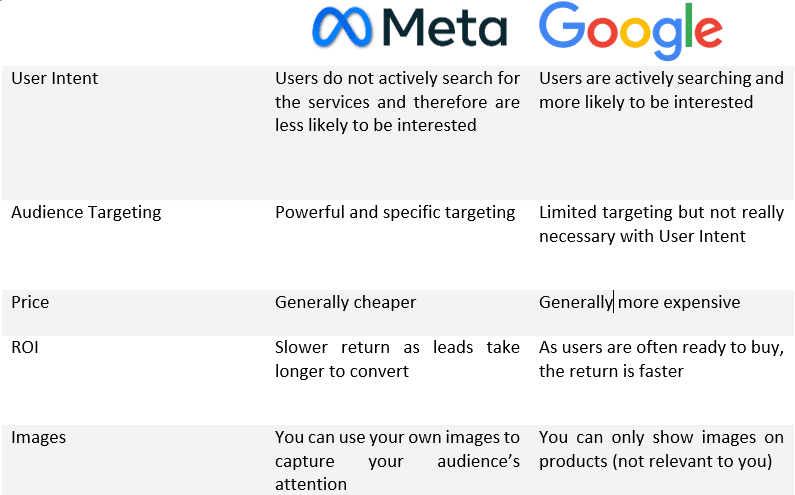When it comes to digital advertising, two platforms dominate the conversation: Google Ads and Facebook Ads. Both offer massive reach, powerful targeting options, and impressive potential for return on investment (ROI). But if you’re a business owner or marketer with a limited budget, you might be asking: Which one delivers better ROI?
The answer isn’t as simple as picking one platform over the other—it depends on your goals, audience, product, and strategy. In this post, we’ll dive deep into the strengths and differences of Google Ads and Facebook Ads, helping you decide where to invest your ad dollars for maximum return.

Understanding the Basics
What Are Google Ads?
Google Ads (formerly Google AdWords) is a pay-per-click (PPC) platform where advertisers bid on keywords. When users search for those keywords, ads appear at the top of the search results page. Google Ads also includes Display Network ads, YouTube ads, and Shopping ads, expanding its reach beyond search engines.
Google Ads are all about intent. People are actively searching for solutions, products, or answers.
What Are Facebook Ads?
Facebook Ads run across Facebook, Instagram, Messenger, and the Audience Network. Instead of targeting keyword searches, Facebook Ads target people based on demographics, interests, behaviors, and custom audiences.
Facebook Ads are about discovery. You’re reaching people based on who they are, not necessarily what they’re searching for at the moment.
Google Ads Strengths
1. High Purchase Intent
When someone searches “best running shoes for flat feet” on Google, they are very likely close to making a purchase. Google Ads captures users at the bottom of the sales funnel, making it easier to drive high-converting traffic.
2. Wide Range of Ad Types
Beyond text search ads, Google offers:
- Display ads (banners on websites)
- Shopping ads (for e-commerce)
- Video ads (on YouTube)
- App promotion ads
This flexibility allows you to match the right ad format to your marketing goals.
3. Massive Reach
Google processes over 8.5 billion searches per day. No matter your industry, your audience is using Google.
4. Detailed Performance Metrics
Google Ads provides in-depth analytics, letting you track everything from impressions and clicks to conversions and ROAS (Return on Ad Spend).
Facebook Ads Strengths
1. Powerful Audience Targeting
Facebook’s targeting capabilities are unmatched. You can build audiences based on:
- Age, gender, and location
- Interests and hobbies
- Purchase behaviors
- Life events (e.g., newly engaged, moving to a new city)
- Lookalike audiences (people similar to your best customers)
This granularity allows for incredibly precise campaigns.
2. Cost-Effective Awareness Building
If your goal is to build brand awareness, Facebook Ads often offer a lower cost per thousand impressions (CPM) than Google Ads. You can reach a broad audience affordably.
3. Visual Storytelling
Facebook and Instagram are highly visual platforms. With the right creative—videos, carousel ads, eye-catching images—you can emotionally connect with users and build a loyal audience.
4. Remarketing Opportunities
You can easily retarget users who visited your website, watched a video, or engaged with your posts. These warm audiences often have higher conversion rates.
Google Ads vs. Facebook Ads: ROI Face-Off

When Google Ads Wins:
- When users know they have a problem or need: If your product or service solves an urgent need, Google Ads are gold. (Example: “emergency plumber near me”)
- High-intent search terms: Google captures people actively looking to buy.
- Local businesses: Search ads are highly effective for driving foot traffic and local service inquiries.
When Facebook Ads Wins:
- When building brand awareness or demand: Facebook is better for products or services users may not realize they need yet. (Example: a new fitness app)
- When targeting specific lifestyles or interests: If you know your audience’s hobbies, interests, or behaviors, Facebook is unbeatable.
- When you have strong creatives: Eye-catching visuals and videos can perform incredibly well and drive impulse buys.
Key Differences in Cost
- Cost per click (CPC) tends to be higher on Google Ads, especially for competitive industries like law, insurance, and finance.
- Cost per impression (CPM) is usually lower on Facebook Ads, making it great for reaching larger audiences at a lower cost.
- Cost per acquisition (CPA) depends heavily on your ad strategy and industry but is often lower on Facebook for top-of-funnel activities and lower on Google for bottom-of-funnel conversions.
In general:
- Google = More expensive, but often higher intent.
- Facebook = More affordable, but requires strong audience targeting and creative strategy.
How to Choose the Best Platform for Your Business
Ask yourself:
- Is my audience actively searching for my product/service?
➔ Choose Google Ads. - Is my product/service something people might buy impulsively or after seeing a compelling ad?
➔ Choose Facebook Ads. - Do I have strong creative assets (images, videos)?
➔ Facebook Ads will shine. - Am I selling a new product or disrupting a market?
➔ Facebook helps build awareness.
👉 Best practice:
For many businesses, a combination of Google Ads and Facebook Ads works best. Use Google Ads to capture high-intent buyers and Facebook Ads to build awareness, nurture leads, and retarget website visitors.
Final Thoughts
Choosing between Google Ads and Facebook Ads isn’t a matter of which platform is “better”—it’s about which one aligns best with your marketing objectives, audience behavior, and available resources.
- If you need to capture demand, Google Ads excels.
- If you need to create demand and awareness, Facebook Ads is a powerful tool.
Both platforms can deliver strong ROI when used strategically. The key is to start with a clear goal, test different campaigns, analyze the results, and optimize over time.
Remember: In digital marketing, experimentation is your friend. You may find your perfect formula by blending both platforms into a single, powerful marketing machine.